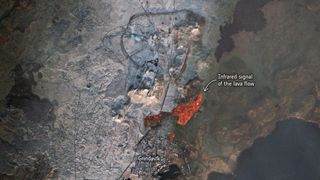
An image of lava reaching the Icelandic town of Grindavík on Jan. 17, 2024. It was imaged by the European Space Agency’s Sentinel-2 satellite.
(Image credit: Copernicus Sentinel data (2024), processed by ESA, CC BY-SA 3.0 IGO)
A tiny town in Iceland stands on the brink of a lava flow, in new images visible from space.
Grindavík has been under continual threat from volcanic eruptions for weeks. The flow originates beneath the Svartsengi volcano system, roughly 2.5 miles (4 km) north of the town, which erupted on Dec. 18 and Jan. 14.
Now, fresh satellite imagery from the European Space Agency’s Sentinel2 satellite has revealed the glow of the lava flow’s heat, not far at all from houses and other infrastructure within Grindavík.
“Magma accumulation continues and there is a continued likelihood that new eruptive fissures may open without warning,” ESA officials wrote in a Thursday (Jan. 18) statement on X (formerly Twitter), citing the Icelandic Met office.
Related: Massive ancient lava flow seen from space looks like a giant black scar on the New Mexico desert

On Jan. 17, 2024, the Copernicus Sentinel-2 mission captured this image of a lava flow in Iceland’s Reykjanes Peninsula. The lava reached the town of Grindavik, which had already been evacuated. (Image credit: ESA, CC BY-SA 3.0 IGO)
Grindavík, a fishing village roughly 25 miles (40 km) from Icelandic capital Reykjavík, is situated nearby the Fagradalsfjall volcano and has faced constant evacuations, as well as mini-earthquakes, the Guardian reported. The town has just 3,800 residents, some of whom have lost houses already.
According to a translated statement from the Iceland Met Office (IMO) reported by Space.com sister website LiveScience, magma continues to build below the surface as had happened before previous eruptions.
“When a magma vent forms near the surface, the earth’s crust is strained and land sinks over the center of the magma vent,” IMO representatives wrote. “Furthermore, the earth’s crust pushes up on either side of it.”
Iceland’s position above a chain of volcanoes in the north Atlantic makes it prone to such eruptions, many of them previously visible from space as well.
The 2010 eruption of the Eyjafjallajokull volcano not only made air travel difficult around Europe for months, but the ash cloud it produced was easily visible from satellites gazing at Earth.
Join our Space Forums to keep talking space on the latest missions, night sky and more! And if you have a news tip, correction or comment, let us know at: [email protected].
Breaking space news, the latest updates on rocket launches, skywatching events and more!
Elizabeth Howell (she/her), Ph.D., is a staff writer in the spaceflight channel since 2022 covering diversity, education and gaming as well. She was contributing writer for Space.com for 10 years before joining full-time. Elizabeth’s reporting includes multiple exclusives with the White House and Office of the Vice-President of the United States, an exclusive conversation with aspiring space tourist (and NSYNC bassist) Lance Bass, speaking several times with the International Space Station, witnessing five human spaceflight launches on two continents, flying parabolic, working inside a spacesuit, and participating in a simulated Mars mission. Her latest book, “Why Am I Taller?”, is co-written with astronaut Dave Williams. Elizabeth holds a Ph.D. and M.Sc. in Space Studies from the University of North Dakota, a Bachelor of Journalism from Canada’s Carleton University and a Bachelor of History from Canada’s Athabasca University. Elizabeth is also a post-secondary instructor in communications and science at several institutions since 2015; her experience includes developing and teaching an astronomy course at Canada’s Algonquin College (with Indigenous content as well) to more than 1,000 students since 2020. Elizabeth first got interested in space after watching the movie Apollo 13 in 1996, and still wants to be an astronaut someday. Mastodon: https://qoto.org/@howellspace
>>> Read full article>>>
Copyright for syndicated content belongs to the linked Source : Space.com – https://www.space.com/iceland-volcano-lava-flow-space-visible































